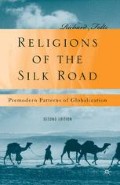Abstract
During the latter decades of the nineteenth century, popular European fascination with the world beyond reached an all-time high. The British and French empires spanned the globe, and their colonial agents sent home exotic goods and stories. Poets and painters put their own visions of the seductive Orient onto paper and canvas.
Access this chapter
Tax calculation will be finalised at checkout
Purchases are for personal use only
Preview
Unable to display preview. Download preview PDF.
Notes
See Morris Rossabi, “The ‘Decline’ of the Central Asian Caravan Trade,” in James Tracy, ed., The Rise of Merchant Empires: Long-Distance Trade in the Early Modern World 1350–1750, Cambridge: Cambridge University Press, 1990, pp. 351–370;
also Niels Steensgard, The Asian Trade Revolution of the Seventeenth Century: The East India Company and the Decline of the Caravan Trade, Chicago: University of Chicago Press, 1974.
Some scholars, however, have recently sought to revise the conventional view of decline in overland trade during this period; see, for example, Muzaffar Alam, “Trade, State Policy and Regional Change: Aspects of Mughal-Uzbek Relations, c.1550–1750,” Journal of the Economic and Social History of the Orient 37 (1994), pp. 202–227,
and Robert McChesney, Central Asia: Foundations of Change, Princeton, NJ: Darwin Press, 1996, pp. 53–54, note 3.
See Peter Hopkirk, The Great Game, Tokyo: Kodansha International, 1992.
See Elena Kuzmina, The Prehistory of the Silk Road, Philadelphia: University of Pennsylvania Press, 2008.
A more general history is David Christian, A History of Russia, Central Asia and Mongolia, Volume 1: Inner Eurasia from Prehistory to the Mongol Empire, Oxford: Blackwell, 1998.
For a collection of studies on specific aspects of this movement see Victor Mair, ed., The Bronze Age and Early Iron Age Peoples of Eastern Central Asia, 2 vols., Washington, D.C.: Institute for the Study of Man, 1998.
Laszlo Torday, Mounted Archers: The Beginnings of Central Asian History, Durham: Durham Academic Press, 1997, p. 91.
By the fifth century even silk was not making the complete trip from China, as it was being produced in Iran, India, and eventually the Byzantine Empire (Xinru Liu, Religion and Silk, Delhi: Oxford University Press, 1996, p. 9).
See Andre Gunder Frank and Barry Gills, eds., The World System: From Five Hundred Years to Five Thousand, London: Routledge, 1992.
See Peter Hopkirk, Foreign Devils on the Silk Road, Amherst, MA: University of Massachusetts Press, 1984 [1980].
Sir Aurel Stein, The Ruins of Desert Cathay, 2 vols., New York: Dover, 1987 [1912], vol. 2, p. 194.
D.S. Margoliouth, “An Early Judeo-Persian Document from Khotan in the Stein Collection, with Other Early Persian Documents,” Journal of the Royal Asiatic Society, 1903, pp. 735–761; Bo Utas, “The Jewish-Persian Fragment from Dandan-Uiliq,” Orientalia Suecana 17 (1968), pp. 123–126.
See, for example, Jerry Bentley, Old World Encounters, New York: Oxford University Press, 1993,
and Philip Curtin, Cross-Cultural Trade in World History, Cambridge: Cambridge University Press, 1984.
See Xinru Liu, Ancient India and Ancient China: Trade and Religious Exchanges, AD 1–600, Delhi: Oxford University Press, 1988, especially pp. 68–69.
Gavin Hambly, Central Asia, London: Weidenfeld and Nicolson, 1967, p. 7.
On Africa see Mervyn Hiskett, The Course of Islam in Africa, Edinburgh: Edinburgh University Press, 1994, pp. 100, 108,
and J.S. Trimingham, The Influence of Islam upon Africa, New York and Washington, D.C.: Praeger, 1968, pp. 38–40.
On Indian Ocean trade see André Wink, Al-Hind: The Making of the Indo-Islamic World, vol. 1, Leiden: Brill, 1990, especially pp. 25–85,
and K.N. Chaudhuri, Asia before Europe: Economy and Civilisation of the Indian Ocean from the Rise of Islam to 1750, Cambridge: Cambridge University Press, 1990.
For a fictionalized portrait of a Sogdian merchant’s world in the eighth century, see Susan Whitfield, Life along the Silk Road, London: John Murray, 1999, pp. 27–54.
See the recent study by Étienne de la Vaissiére, Sogdian Traders: A History, tr., James Ward, Leiden: Brill, 2005.
See Richard Frye, The Golden Age of Persia, London: Weidenfeld and Nicolson, 1975, pp. 150–174.
See Richard Frye, Bukhara: the Medieval Achievement, Costa Mesa, CA: Mazda Publishers, 1997 [1965].
See Donald Leslie, The Survival of the Chinese Jews, Leiden: Brill, 1972, pp. 18 ff.
Sergei P. Poliakov, Everyday Islam: Religion and Tradition in Rural Central Asia, Armonk, NY: M.E. Sharpe, 1992, especially pp. 59–75.
Richard Eaton, The Sufis of Bijapur, 1300–1700, Princeton, NJ: Princeton University Press, 1978, pp. 155–174.
Translation by Nicholas Sims-Williams in Susan Whitfield and Ursula SimsWilliams, eds., The Silk Road: Trade, Travel, War and Faith, Chicago: Serindia, 2004, p. 249. These letters were most likely dictated to a professional letter writer, since women at the time were mostly illiterate.Since the letters were found in Dunhuang, presumably they were never delivered.
Peter Bryder, “Cao’an Revisited,” Research into China Overseas Communication History 16/2 (1989), pp. 35–42, and “… Where the Faint Traces of Manichaeism Disappear,” Altorientalische Forschungen 15/1 (1988), pp. 201–208.
Copyright information
© 2010 Richard Foltz
About this chapter
Cite this chapter
Foltz, R. (2010). The Silk Road and Its Travelers. In: Religions of the Silk Road. Palgrave Macmillan, New York. https://doi.org/10.1057/9780230109100_1
Download citation
DOI: https://doi.org/10.1057/9780230109100_1
Publisher Name: Palgrave Macmillan, New York
Print ISBN: 978-0-230-62125-1
Online ISBN: 978-0-230-10910-0
eBook Packages: Palgrave History CollectionHistory (R0)

